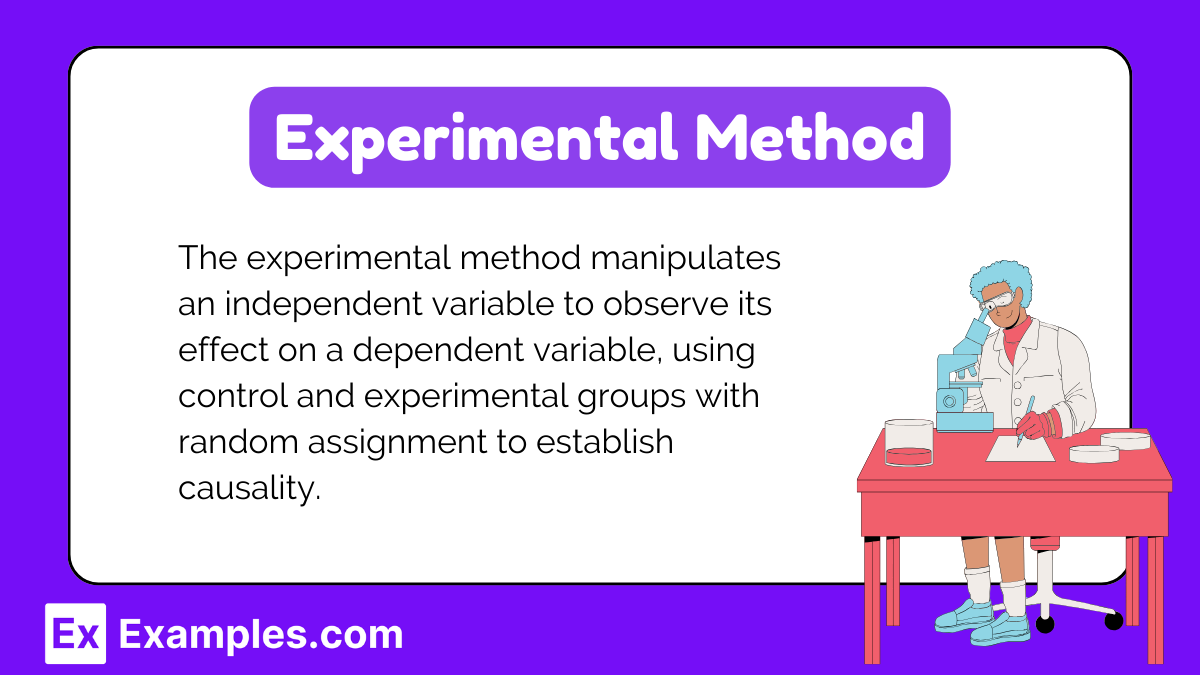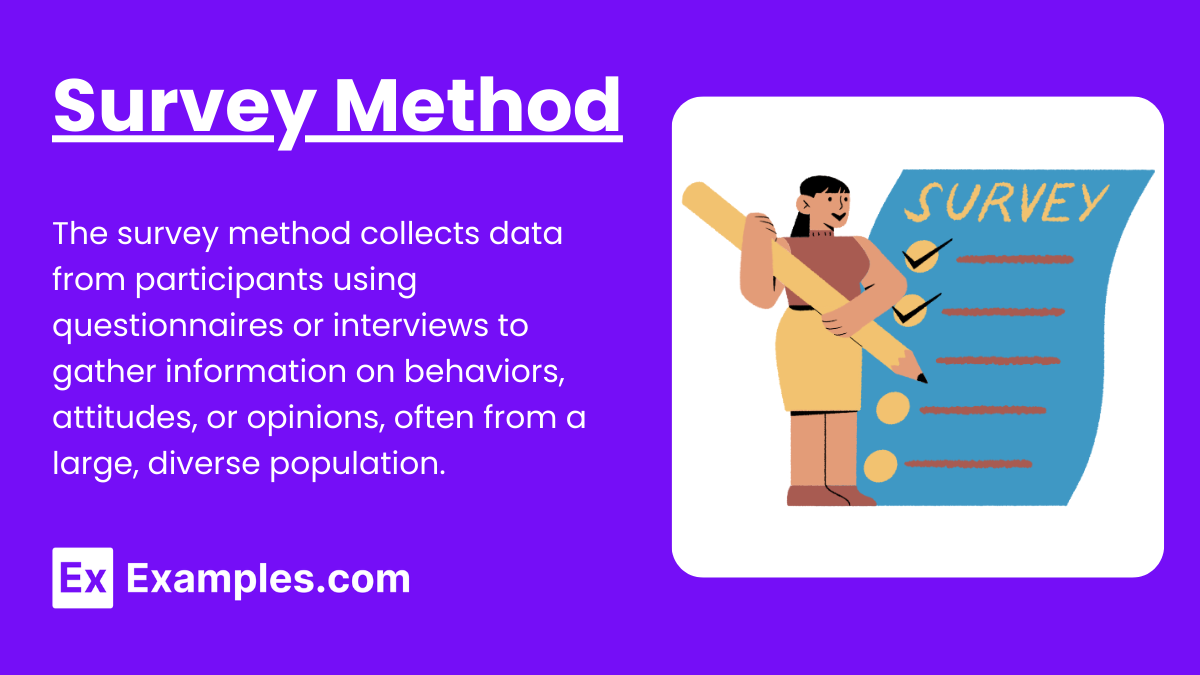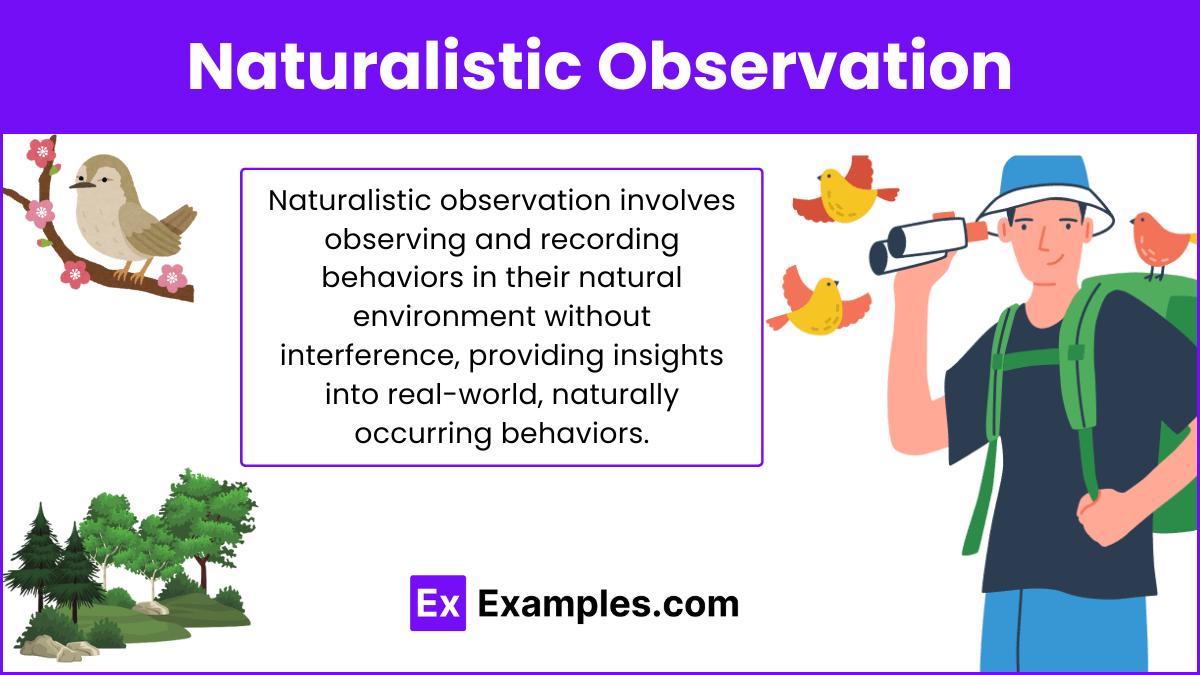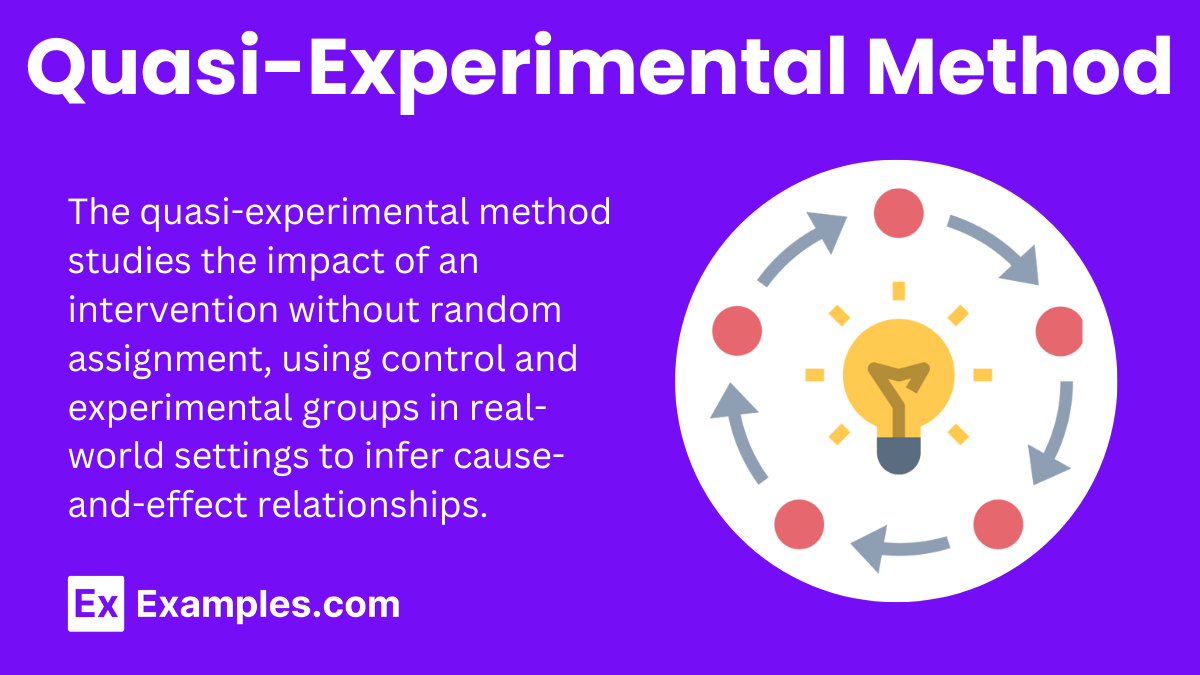Psychologists employ a variety of research methods to investigate human behavior and mental processes. These methods, essential for the AP Psychology curriculum, include experimental, correlational, survey, naturalistic observation, case study, longitudinal, and cross-sectional methods. Each approach offers unique insights and has specific applications, strengths, and limitations. Understanding these methods allows students to critically analyze psychological studies and appreciate the diverse techniques used in psychological research. Mastering these research methods is crucial for success in AP Psychology, as they form the foundation for evaluating and conducting psychological experiments and understanding human behavior scientifically.
Learning Objectives
Understand the experimental method, including independent and dependent variables, control groups, experimental groups, random assignment, and replication. Study examples and evaluate its strengths and limitations. Learn the correlational method, focusing on correlation coefficients, positive and negative correlations, and the distinction between correlation and causation. Understand the survey method, covering self-report, sampling, questionnaire design, administration, and data analysis, along with examples and their strengths and weaknesses. Learn about naturalistic observation, focusing on real-world settings, non-intrusive observation, and detailed data collection. Study the case study method, emphasizing detailed information, multiple data sources, and contextual analysis. Finally, understand longitudinal and cross-sectional methods, focusing on tracking changes over time and comparing different age groups, with an emphasis on their strengths and limitations.
1. Experimental Method
Definition: The experimental method is a research technique that involves manipulating an independent variable to determine its causal effect on a dependent variable, typically with the use of control and experimental groups and random assignment to ensure valid and reliable results.
Key Features :
Manipulation of Variables: Researchers manipulate an independent variable (IV) to observe its effect on a dependent variable (DV).
Control Group: A group that does not receive the experimental treatment, serving as a baseline for comparison.
Random Assignment: Participants are randomly assigned to different groups to ensure that each group is similar before treatment.
Key Components :
Manipulation of Variables: Researchers deliberately change one variable (the IV) to observe its effect on another variable (the DV). For example, a psychologist might manipulate the amount of sleep participants get to see its impact on memory performance.
Control Group: This group does not receive the experimental treatment and serves as a baseline to compare the effects of the IV. The presence of a control group helps isolate the effect of the IV by providing a standard for comparison.
Experimental Group: This group receives the treatment or condition being tested. By comparing the results of the experimental group with those of the control group, researchers can determine the effect of the IV.
Random Assignment: Participants are randomly assigned to either the control or experimental group to ensure that each group is similar in all respects except for the manipulation of the IV. This randomization minimizes potential biases and confounding variables that could affect the results.
Replication: To establish the reliability and validity of findings, experiments are often replicated. Replication involves repeating the study with different participants and in different settings to confirm the results.
2. Correlational Method
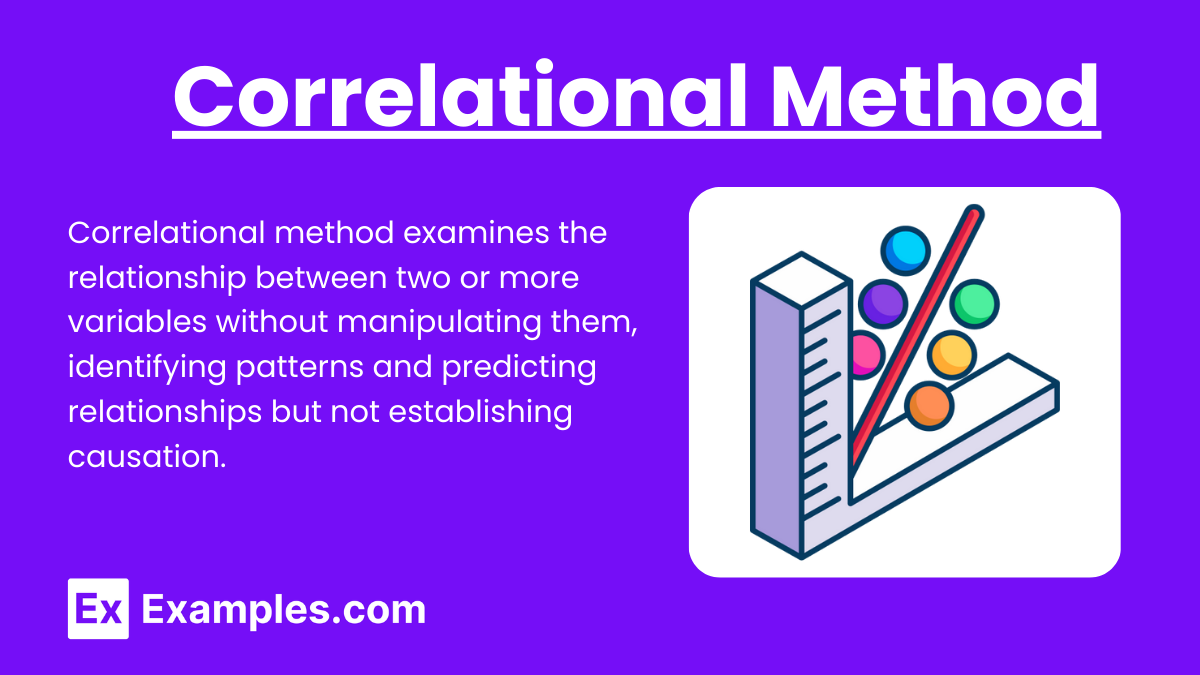
Definition: The correlational method is a research technique that involves measuring two or more variables to determine if a relationship exists between them, using statistical measures to assess the strength and direction of the association.
Key Features:
Correlation Coefficient: A statistical measure that describes the strength and direction of the relationship between variables, ranging from -1 to +1.
No Causation: Correlation does not imply causation; it only indicates a relationship between variables.
Key Components:
Correlation Coefficient: This statistical measure describes the strength and direction of the relationship between variables. It ranges from -1 to +1, where +1 indicates a perfect positive correlation, -1 indicates a perfect negative correlation, and 0 indicates no correlation.
Positive Correlation: When both variables increase or decrease together. For example, as study time increases, test scores also increase.
Negative Correlation: When one variable increases while the other decreases. For example, as stress levels increase, quality of sleep decreases.
No Causation: Correlation does not imply causation. A correlation between two variables does not mean that changes in one variable cause changes in the other. Other factors, known as confounding variables, might influence the observed relationship.
Scatterplot: A graphical representation of the relationship between two variables. Each point on the scatterplot represents an observation, helping to visualize the correlation.
3. Survey Method
Definition: The survey method is a research technique that involves collecting data from a large number of respondents using structured questionnaires or interviews to gather information about their behaviors, attitudes, opinions, and other characteristics.
Key Features:
Self-Report: Participants provide information about themselves, often leading to large datasets.
Sampling: The process of selecting a representative group from the population to generalize findings.
Key Components:
Self-Report: Participants provide information about themselves, offering insights into their thoughts, feelings, and behaviors. This can be done through various means such as paper questionnaires, online surveys, or face-to-face interviews.
Sampling: The process of selecting a representative group from the larger population. Sampling methods can include random sampling, stratified sampling, or convenience sampling, each affecting the generalizability of the findings.
Questionnaire Design: Effective surveys require well-designed questions that are clear, unbiased, and relevant to the research objectives. Questions can be open-ended, allowing for detailed responses, or closed-ended, providing specific options for respondents to choose from.
Administration: Surveys can be administered in different ways, including in-person, over the phone, by mail, or online. Each method has its advantages and challenges in terms of reach, cost, and response rates.
Data Analysis: Survey responses are analyzed to identify patterns, trends, and relationships within the data. Statistical techniques are used to summarize and interpret the findings, which can then inform conclusions and recommendations.
4. Naturalistic Observation
Definition: Naturalistic observation is a research technique in which a researcher observes subjects in their natural environment without any manipulation or intervention, aiming to collect data on naturally occurring behaviors.
Key Features:
Real-World Setting: Observations occur in the natural environment where behavior typically occurs.
Non-Intrusive: Researchers do not manipulate variables or interact with the subjects.
Key Components:
Real-World Setting: Observations are conducted in the natural environment where behavior typically occurs, such as homes, schools, workplaces, or public places. This approach enhances the ecological validity of the findings.
Non-Intrusive: Researchers do not manipulate variables or interact with the subjects. Their role is to observe and record behaviors unobtrusively to ensure that their presence does not influence the behavior being studied.
Detailed Data Collection: Observers take detailed notes, make recordings, or use coding systems to systematically capture specific behaviors and events. This can include both qualitative and quantitative data.
Contextual Understanding: This method allows researchers to understand behaviors within the context in which they occur, considering environmental and situational factors that might influence actions.
5. Case Study

Definition: A case study is a research technique that involves an in-depth investigation of a single case or a small number of cases, providing detailed insights and a thorough understanding of the subject being studied.
Key Features:
Detailed Information: Provides comprehensive information about the subject's life and behavior.
Qualitative Data: Often involves interviews, observations, and analysis of personal documents.
Key Components:
Detailed Information: Case studies provide comprehensive information about the subject's history, development, and current status. This includes personal, social, and contextual factors.
Multiple Sources: Researchers use various data sources such as interviews, observations, documents, and archival records to gather detailed information. Triangulation of these sources enhances the reliability of the findings.
Qualitative Data: Most case studies involve qualitative data, offering rich, descriptive insights into the subject's experiences and behaviors. However, quantitative data can also be included to complement the analysis.
Contextual Analysis: The subject is studied within its real-life context, allowing researchers to consider environmental, social, and cultural factors influencing the subject.
Unique or Rare Cases: Case studies often focus on unique, rare, or interesting cases that provide valuable insights not easily obtained through other research methods.
6. Longitudinal and Cross-Sectional Methods
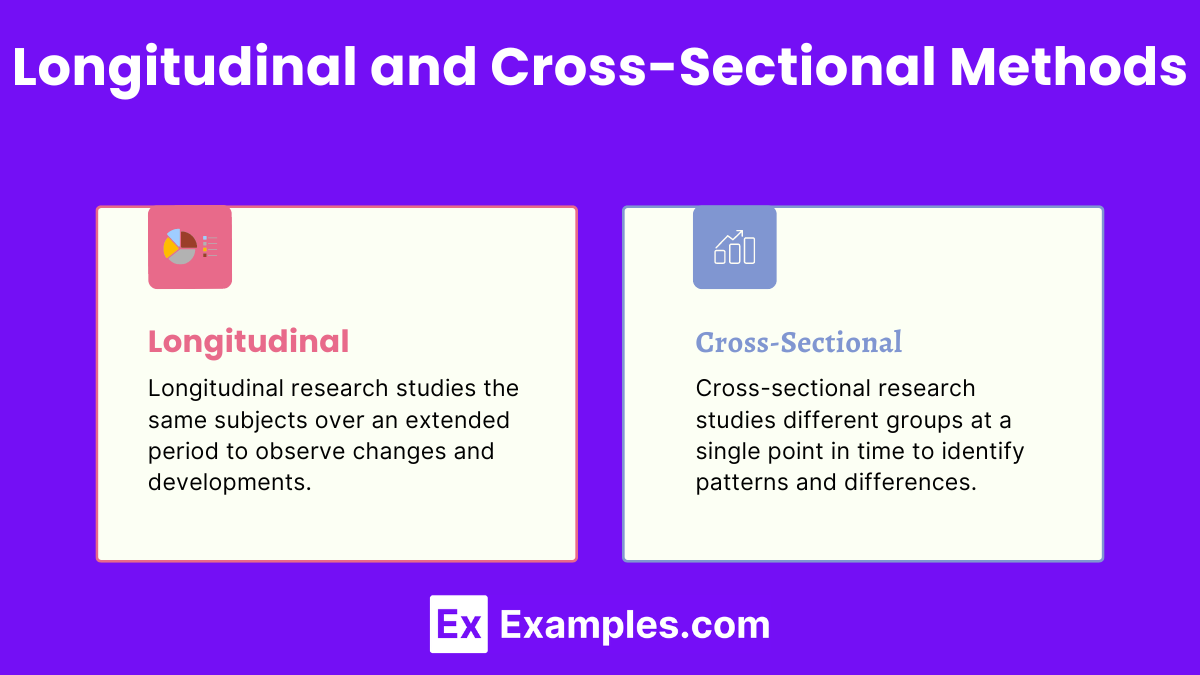
Longitudinal Method
Definition: The longitudinal method is a research technique that involves repeated observations or measurements of the same participants over a long period, often spanning several years or even decades.
Key Features:
Time Frame: Data is collected at multiple time points.
Developmental Changes: Useful for studying developmental and life-span changes.
Key Components:
Time Frame: Data is collected at multiple time points from the same subjects. This can range from months to many years.
Developmental Changes: The method is particularly useful for studying how individuals change and develop over time, including cognitive, emotional, and behavioral changes.
Consistency: By following the same participants, researchers can control for individual differences and directly observe changes.
Attrition: One of the main challenges is participant dropout over time, which can affect the study's validity.
Cross-Sectional Method
Definition: The cross-sectional method is a research technique that involves observing or testing different groups of individuals of various ages or stages at a single point in time to infer differences and similarities across these groups.
Key Features:
Snapshot: Provides a snapshot of a particular population at a specific time.
Age Comparisons: Often used to compare different age groups.
Key Components:
Snapshot: Provides a snapshot of a particular population at a specific time, capturing differences between groups based on age, developmental stage, or other relevant factors.
Age Comparisons: Often used to compare different age groups to understand how certain traits or behaviors vary with age or developmental stage.
Efficiency: More time-efficient and less costly than longitudinal studies since all data is collected simultaneously, allowing for quicker results.
Cohort Effects: Differences observed between age groups may be due to generational or cohort effects rather than true developmental changes. Researchers must be cautious about attributing differences solely to age or development.
7. Quasi-Experimental Method
Definition: The quasi-experimental method is a research technique that involves the manipulation of an independent variable without the random assignment of participants to control and experimental groups, aiming to determine cause-and-effect relationships in real-world settings.
Key Features:
Non-Random Assignment: Participants are not randomly assigned to groups, which may introduce confounding variables.
Real-World Settings: Often used in natural settings where random assignment is not feasible.
Key Components:
Non-Random Assignment: Participants are assigned to groups based on existing characteristics or other non-random criteria, which can introduce selection biases and confounding variables.
Manipulation of Variables: Researchers manipulate an independent variable (IV) to observe its effect on a dependent variable (DV), similar to true experiments.
Control Groups: Although groups are not randomly assigned, control groups are often used to provide a comparison for the experimental group.
Real-World Settings: Quasi-experiments are typically conducted in natural settings, increasing the ecology validity of the findings.



